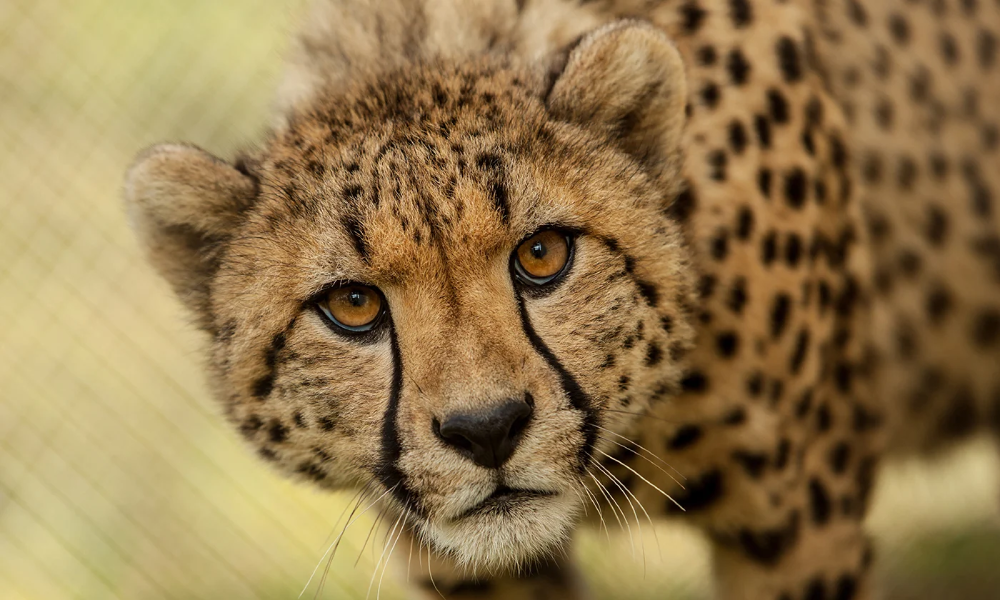The cheetah (Acinonyx jubatus) stands as one of nature’s most remarkable predators. Renowned for its unparalleled speed and agility, this magnificent animal embodies a unique blend of power, grace, and vulnerability. The cheetah’s distinct characteristics and behaviors have fascinated scientists and nature enthusiasts alike, making it a subject of extensive study and admiration.
Physical Characteristics
The cheetah’s body is exquisitely adapted for speed. Weighing between 77 to 143 pounds and standing about 28 to 35 inches tall at the shoulder, the cheetah possesses a lightweight frame that enhances its velocity. Its long legs, flexible spine, and powerful muscles contribute to its extraordinary acceleration. The cheetah’s semi-retractable claws provide additional grip, while its large nasal passages ensure ample oxygen intake during high-speed chases. Its tail, functioning as a rudder, helps maintain balance and agility during rapid turns.
The cheetah’s coat is another distinctive feature, adorned with black spots scattered across a tan or yellow background, providing effective camouflage in its savanna habitat. Unique black tear marks run from the inner corners of their eyes down to the sides of their mouths, reducing sun glare and aiding in hunting by improving focus on prey.

Speed and Hunting Techniques
Cheetahs are the fastest land animals, capable of reaching speeds up to 60 to 70 miles per hour in short bursts covering distances up to 500 meters. This incredible speed is primarily used in hunting, as cheetahs rely on stealth and sprinting ability to capture their prey, which mainly includes antelopes, gazelles, and smaller mammals.
The hunting process is a testament to the cheetah’s prowess. The cheetah stalks its prey, keeping low to the ground and moving with stealthy precision. When within 60 to 70 feet of the target, it launches into a high-speed chase. The chase typically lasts less than a minute, during which the cheetah must overtake and trip its prey using a swift swipe of its paw. Once the prey is down, the cheetah suffocates it by clamping down on its throat. Despite their hunting skills, cheetahs must eat quickly to avoid losing their kill to larger predators like lions and hyenas.
Social Structure and Behavior
Unlike many other big cats, cheetahs exhibit a unique social structure. Female cheetahs are generally solitary, except when raising cubs. They occupy large home ranges that can overlap with those of other females. Male cheetahs, on the other hand, often form small groups called coalitions, usually consisting of brothers from the same litter. These coalitions enhance their ability to defend territories and improve hunting success.
Cheetah cubs are born after a gestation period of about three months, and a typical litter consists of three to five cubs. The cubs are initially blind and helpless, relying entirely on their mother for food and protection. During the first few weeks of life, the mother moves her cubs frequently to avoid detection by predators. As they grow, the cubs begin to learn essential survival skills, such as stalking and hunting, by observing and mimicking their mother. By the time they are 18 months old, the cubs are usually ready to fend for themselves.
Threats and Conservation
The cheetah faces numerous threats that have led to a dramatic decline in its population. Habitat loss due to agricultural expansion, human-wildlife conflict, and poaching are among the primary challenges. Additionally, the cheetah’s genetic diversity is low, making it more susceptible to diseases and reducing its adaptability to environmental changes.
Conservation efforts are crucial to the survival of this iconic species. Various organizations and wildlife reserves work tirelessly to protect cheetah habitats, mitigate human-wildlife conflict, and promote breeding programs to enhance genetic diversity. Public awareness and education campaigns also play a significant role in garnering support for cheetah conservation.
Conclusion
The cheetah’s speed and grace have earned it a place of reverence in the animal kingdom. Its unique adaptations and behaviors highlight the incredible diversity of life on Earth. However, the survival of the cheetah is precariously balanced against numerous threats. Continued conservation efforts are essential to ensure that future generations can marvel at the sight of this extraordinary predator racing across the savannas. Through a combination of scientific research, habitat protection, and global awareness, we can help preserve the cheetah’s place in the natural world.









